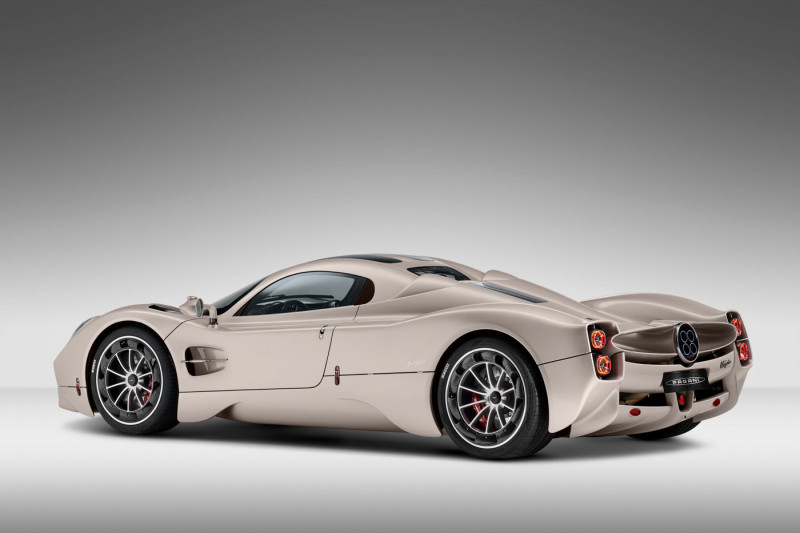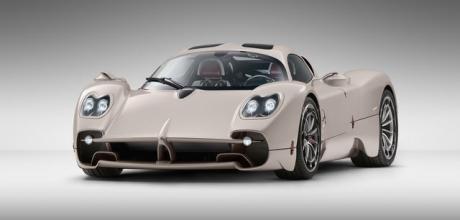2023 Pagani Utopia
Pagani’s third Hypercar. First came Zonda, then Huayra. Now Pagani reveals its third model, the Utopia. In a world where hypercars are almost commonplace, this one still promises to be very special indeed.
Pagani’s third act
In the near quarter of a century since its now-iconic Zonda first appeared on a stand at the Geneva motor show, and three decades since Horacio Pagani established his eponymous car company, this is only its third car. Yes, there have been coupe and roadster versions of both Zonda and Huayra, track specials and limited editions – lots of limited editions in fact, nearly as many as Porsche knocks out 911s – but the new Utopia, codenamed C10, makes the trilogy.

Utopia bears more than a passing resemblance to the original Zonda, with its rakish nose, squared-off tail and quartet of exhaust pipes. Unmistakably a Pagani, there’s a uniqueness to its design that makes most of today’s crop of unobtainable hypercars – Utopia customers will hand over at least £2.2million in return for one of the 99 coupe examples that will be produced – look a little generic in their pursuit of aerodynamic superiority.
The brief handed to Pagani’s team of designers and engineers was as much shaped by the owners of the firm’s original cars as by the man who founded the company. More performance was a given; people always want more. An improved structure was on the wish list, too, as were improved aerodynamics. These were core to the C10’s development, but there was more on that list. A lighter car was essential, so too simplicity, and most important of all was a focus on driving, something Horacio Pagani has always held dear.
Following these criteria has seen Pagani ignore the trends towards complex and heavy hybrid power systems and dual-clutch transmissions, instead sticking with its tried and tested formula of a V12 engine and manual gearbox. Visually, Utopia takes inspiration from 1950s and ’60s design – the headlamps of a Vespa scooter and the detail fittings of a Riva speedboat, for example, have been blended with elements of the Zonda’s original design. Meanwhile, advancements in aerodynamics have allowed Pagani, as it did with the Huayra, to incorporate the majority of the Utopia’s aerodynamic features under the skin rather than fixing them to its surface.
Some elements are visible, including the front splitter. The aerofoil supports for the wing mirrors have been shaped in the wind tunnel, too, and the rear lights are ‘suspended’ in vents that aid extraction of turbulent air from the rear wheel wells as well as allowing heat from the engine bay to escape. The rear body section incorporates active aero that ‘stalls’ the air over the car to maximise the aero balance front-to-rear, resulting in a 46/54 per cent split. The wheels include turbine-shaped extractors that draw hot and turbulent air away from the brakes and body.
Under the carbonfibre skin is a further evolution of Pagani’s composite monocoque chassis that has benefited from continuous development over the decades. Constructed from advanced Carbo- Titanium HP62 G2 and Carbon-Triax HP62, torsional rigidity increases by 10.5 per cent over the Huayra. In combination with the new carbon body, torsional stiffness has increased by a total of 38 per cent.
Many of the components not shaped from carbonfibre are machined from solid billets of aluminium, while the signature exhaust system is made from titanium and weighs just 6kg. The net result is that the Utopia weighs 1280kg dry, 70kg less than the Huayra, although 70kg more than the Zonda weighed when it first appeared 23 years ago.
Utopia’s active aero is synced to its independent double-wishbone suspension and semi-active dampers, with the former machined from solid aluminium. The dampers have been further developed, says Pagani, to provide the new car with a better blend of road and track performance, the famed on-road composure not compromised while the latter is enhanced. A great deal of what has gone into the damper software and tuning was apparently learned from the extreme Huayra R track car. Brembo, meanwhile, had responsibility for the Utopia’s braking system, opting for 410mm carbon-ceramic discs and six-piston calipers at the front, 390mm discs and four-pots at the rear.
The powertrain follows in the shockwaves of Pagani’s previous models by sticking with AMG power. A lot of AMG power. Still designed and manufactured exclusively for Pagani, the 5.9-litre, twin-turbo V12 now produces 852bhp at 6000rpm and 811lb ft all the way from 2800 to 5900rpm. That’s 24bhp up on the most powerful roadgoing Huayra. Key to the performance shove is an uprated valvetrain that lifts the limiter to 6700rpm.
The engine meets all global emission regulations. Two transmission choices are offered, neither conventional for such a car, but then it’s Pagani, so you didn’t expect conventional, did you? Those looking for the quickest Utopia will go for the seven-speed automated manual developed by Xtrac; those looking for purity will want to consider the seven-speed manual. Both feature an electromechanical differential and triple-plate racing clutch. The 21- and 22-inch wheels are forged aluminium items created by APP Tech and can be fitted with a choice of two tyre options, both Pirelli: P Zero Corsas or Sottozero winter rubber in 265-section front and 325 rear sizes.
The cabin remains typically Pagani, free of large digital displays and with plenty of leather, technical metalwork and that trademark exposed gear linkage. New for the Utopia, though, are dials featuring ‘skeleton’ elements to reveal the movement within, while there are new illuminated sections throughout the cabin, and the steering wheel has been redesigned and is another item machined from a single block of aluminium. In normal times the arrival of a new, two-million-pound hypercar would spike the interest of all but the few who will always prefer the merits of a Vauxhall Belmont over a 200mph performance car. Yet these are not normal times and new hypercars are almost more common than new hot hatches. Our industry is a little bit broken in that respect.
Yet the new Pagani sparks more than passing interest. It’s not trying to reinvent the hypercar genre. It doesn’t claim to be 3D-printed from unicorn fur. Neither does it claim to bring Formula 1 technology and performance to the road (because we all know how well that’s going, don’t we Aston Martin and AMG?). It doesn’t claim to be the fastest (there isn’t a single performance figure quoted in any of the press material provided), nor the quickest around any given circuit, or the most powerful. Crucially, though, Pagani has plenty of customers who want to buy one, something that many others building ICE and EV equivalents, Gordon Murray Automotive aside, are struggling with.
When evo first stumbled across the Pagani stand at the Geneva motor show in 1999, we discovered a car company that wanted to create the best supercar for drivers it possibly could. Its philosophy was rooted in driver engagement and fun rather than chasing headlines and performance benchmarks. It would appear that during the intervening two and half decades very little has changed, and Horacio Pagani’s vision remains as compelling as ever.
Right and below: hints of Zonda in the bodywork; cabin is as beautifully detailed as ever; wheels have a turbine effect to draw hot air away from brakes.


